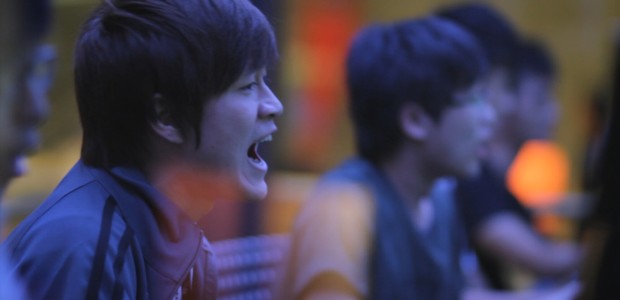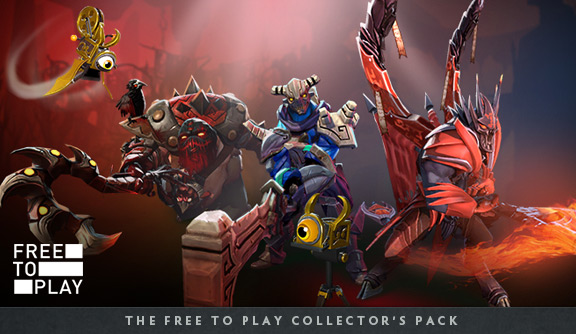
Mar 21, 2014
Dota 2

Every week, the PC Gamer team pick their most and least favourite happenings from the last seven days. Here you'll find the week's soaring highs and stagnant lows, picked from the news, the games we've played, the culture at large. The only thing that's guaranteed is there'll be no neutral opinions.
On this page, you'll find a profusion of positivity; on the next, a glut of gloom.
THE HIGHS
Samuel Roberts: I loved what I played of Alien Isolation this week. It's pretty cool that a game experimenting with emergent AI just happens to be based on a sci-fi franchise that has a recent spotty history when it comes to...well, look, the easiest way of putting this is, Colonial Marines was a pile of arse. This is so far from any other Alien game stylistically and benefits from Creative Assembly's laser focus on the values of the original Alien. Tom's experiences contrasted nicely with my own, so I'm now fairly confident in Isolation's potential replay value based on what I've seen so far.
Evan Lahti: Guys, Clockwork Empires could be special. I posted my hands-on with the indie, Dwarf Fortress-inspired, Lovecraftian colony-builder earlier this week, and as the rest of the press have begun to see the game at GDC they've been echoing our praise and interest. That includes our pals at RPS, who described it as "really exciting stuff."
We've seen a surge in popularity in games that generate emergent, personal stories in the past few years, and I have a feeling that Clockwork is going to be the next big one on that list. Gaslamp Games' eccentricity is infectious whenever I talk to them, and it's wonderful to see how that's extending to the design of their game--you can build barber shops on the frontier (and barbers operate as low-level doctors when none are available, apparently), and phrenologist will be a middle-class occupation for your colonists that's used to identify their character traits. Gaslamp's willingness to be themselves--that is, weird--is encouraging.
Tim Clark: An easy one for me: Sam and I getting to play Hyper Light Drifter for the first time. Most of the session was spent accusing each other of sausage-thumbed incompetence as our survival runs in the horde mode were cut short by sudden death, but when it came to the end of the hands-on it was a genuine wrench to hand the controllers back. Although developer Heart Machine isn't showing Hyper Light Drifter's main RPG elements yet, spending time with the gloriously whipcrack combat system, which is a frantic mess of slash 'n' dash moves fleshed out with a diverse suite of secondary abilities, has left me feeling entirely confident about the feel of the final game. And given its already startlingly cool looks, the hype for Hyper Light Drifter is only set to grow.
Tyler Wilde: That's cool, you all sat in rooms looking at screens with things happening on them. I mean, that's PC gaming for the most part. Totally understandable that you would do that, but here's a story from my week: I'm sitting in a room it's clean, nicely decorated. Someone's apartment, maybe. I turn my head and see another player sitting nearby. He turns his head toward me he's looking at me, right now, through his own Oculus Rift. What do I look like? It occurs to me that I don't know. I look down and my virtual chest shifts slightly. I seem to be wearing a hoodie like his. I see my hands, gripping a controller and frighteningly paralyzed. But what if I weren't paralyzed? What if I could get up and walk over to the strange, silent man sitting next to me? What if his mouth opened and he spoke? Later in the day, would this feel like any other memory of a place I'd been and a person I met?
I'm actually starting to worry about virtual reality, guys not that it won't be good, but that it will be too good. The Oculus Rift Development Kit 2 isn't there yet, but it's a lot better than DK1, and the consumer version is supposed to be another leap. And then there's five years from now, and 10 years from now. Are we heading toward the thing sci-fi writers have been warning us about all this time? Maybe. And maybe if we are, I want it to happen anyway. Long live the new flesh.
Chris Thursten: Given that I've been sat in a big empty office with Phil while the rest of you have adventures at GDC, the highlight of my week has been the release of Valve's Dota 2 documentary, Free To Play. I'd seen it a few times before - I watched an early cut at Valve in May last year, then saw the near-final thing at The International in August - but watching the community get to experience it has been a lot of fun. It's an accomplished exploration of what makes competitive gaming so exciting, and its positivity about the scene has brought about a great sense of positivity within the scene, which makes for a nice change of pace. I wrote about it in more detail as part of this week's Three Lane Highway column. I'd love to see more developers take their communities seriously in the way that Valve evidently do.
Phil Savage: It's been a week of cool tech, exciting previews, and being sat in a big empty office with Chris. And yet, the thing that excited me the most? New payment models for game engines. This could be a sign that I need to take a long, hard look at how I get my thrills, but let me explain what I hope Epic and Crytek's subscription models will mean. Unity has revolutionised the indie industry, partly because of its (relative) ease-of-use for those starting out in 3D development. But it's also the de-facto choice for AAA veterans moving to the indie space. Now, as increasingly more of these smaller studios appear, they'll have the option of an affordable version of tools they're already familiar with. Hopefully it's another step towards a future in which lines between indie and AAA are increasingly blurred, and a studio's budget is no longer it's defining characteristic.
THE LOWS
Tim Clark: As a serious Left 4 Deadhead, I was a little disappointed to find I didn't entirely love my hands-on with Evolve here at GDC. It ought to work. The idea of four-player extraterrestrial big game hunting, with another person controlling the monster, feels rich with promise. The weapon set and abilities all make sense, and the art design is fine, if a little cookie cutter sci-fi. (The current monster, called the Goliath, reminded me most of '90s creature features like The Relic.) And yet There's something about having to chase around after an enormous beast with an equally monolithic health bar that feels unsatisfying. Perhaps that's no surprise: chipping energy away from tank characters or bosses is rarely satisfying in itself, and the core trap and track mechanic doesn't seem intrinsically fun enough to compensate. There's a logic to Turtle Rock's assertion that a human-controlled antagonist ought to trump an AI, but equally isn't that exactly the idea they set at out to disprove with the canny adaptive AI of Left 4 Dead, which had 'The Director' to drop in threats at the perfect moment?
Evan Lahti: Steam Controller. It made a rough first impression. It's also a bit concerning that Valve isn't showing a wider set of games with the controller, despite saying in the announcement that Valve had "fooled those older games into thinking they're being played with a keyboard and mouse." GDC was a perfect opportunity to showcase the flexibility of the controller on a wider set of the Steam library, but instead we got a point-and-click game, Portal 2, and a side-scrolling action game.
Cory Banks: I wouldn't say I was wildly excited about Goat Simulator when it was first announced. I don't particularly want to be a goat, and I'm not dying to be a goat farmer (though maybe I'd be great at it. Food for thought). But when I found out that Goat Simulator is little more than a joke physics game, I was pretty let down. The cool thing about our recent trend of mundane simulation games Euro Truck Simulator 2, for instance is that they highlight the complexity and challenge in tasks that we often take for granted in the real world. Once I found out that Goat Sim is a game where you toss goats, I started imagining how interesting a real Goat Simulator could be: maintaining farm land, balancing operational costs with revenue brought in from goat milking operations, deciding to start a petting zoo so Benny The Goat can entertain children in the town.
So maybe it doesn't sound fun on paper, but there's more game there than an Angry Birds clone. And it's not like hauling cargo across Germany was the most fun game pitch ever, either. But it worked. Taking a jokey concept and turning it into a full, complex game would have been quite a feat.
Tyler Wilde: Despite the $350 dollars I'm about to blow on an Oculus Rift DK2, I'm a little disappointed to hear that when CCP's VR dogfighting game EVE Valkyrie is released alongside the consumer model, it will be exclusive to the Oculus Rift on PC. The Rift may be the biggest VR headset right now, but there will be competitors (not counting Sony's Project Morpheus, though I expect someone will make PC drivers pretty quickly). I hope the industry agrees on some standards so that VR games can be made to work with as many VR headsets as possible, and I hope this Rift exclusivity doesn't continue past launch. I don't want to choose VR hardware for the games that work with it.
Chris Thursten: Honestly, this has been a pretty good week. I've not been especially enraged or disappointed by anything. In part, this is because I have been sat in a big empty office with Phil. My low point for this week is less a specific announcement, then, and more the general state of a particular game.
BioWare announced a form of player housing for Star Wars: The Old Republic this week - and it looks great. I got a huge amount out of SWToR during my time with it, and I'd love to see it succeed. Yet I'm all too aware of the way its haphazard transition to free-to-play drove players away and broke the back of a community I liked being part of. As much as I'm tempted to return, the way the game has been picked apart for monetisable bobbins makes it a world that I'm no longer really comfortable occupying. There's a parallel dimension where player housing is being announced after a long series of successful, story-extending expansions - the kind of thing the game desperately needed. I'd like to live in that dimension. Sadly, I don't.
Phil Savage: I'm starting to suspect there's a secret industry raffle, deciding the fate of beloved gaming franchises. "Sorry Dungeon Keeper, you're becoming a maligned mess of mobile microtransactions." "Congratulations Baldur's Gate, you'll get a competent series of Enhanced Editions, and a spiritual successor on Kickstarter." This week, it was RollerCoaster Tycoon's turn, and, on the basis of the mobile game's trailer, it's not a ride I'm planning to take. Atari also announced a "PC experience", but it's not just their refusal to use the word "game" that has me worried. Looking at the revenue report of a company recovering from bankruptcy, it's clear that their interests are in the "Mobile" and "Online" space. Given that, I doubt we'll be getting the sort of sequel that fans have been waiting nearly a decade for.









